The Friends of the Wildflower Garden, Inc.
Plants of the Eloise Butler Wildflower Garden
The oldest public wildflower garden in the United States

Common Name
European Lily-of-the-valley
Scientific Name
Convallaria majalis L. var. majalis
Plant Family
Lily (Lilaceae)
newer - Ruscaceae
Garden Location
Woodland - possibly extripated.
Prime Season
Late Spring Flowering - May into June
Lily-of-the-Valley is a cultivated and naturalized low growing plant with an erect flowering stem.
The leaves are basal on a single stalk from the root. The stalk can be 3 to 8 inches long with a sheath at the base. Leaf blades rise from the sheath and usually number 2 but 3 are known. They are held erect, but bending backward slightly, the blade oblong to widely elliptic, without hair or teeth on the margins and remain green all summer. The mid-rib forms a keel causing a slight "V" shape to the blade. Secondary veins are all parallel to the mid-rib. Leaves are 8 to 16 inches long and 1 to 3 inches wide, with pointed tips. Most leaves will be around 8 inches long and 1 to 3 wide.
The inflorescence is a upright scape (a flowering stem rising directly from the root) of 5 to 15 stalked flowers, all on one side of the scape. The scape is without leaves, but rises in the same sheath as the leaves. The scape is at least equal in height to the length of the lowest leaf.
The flowers are nodding, fragrant, with a small pointed bract at the base of each flower stalk, the bract shorter than the stalk. The perianth of the flower is a bell shape with 3 sepals and 3 petals that look the same (commonly called 'tepals') and as the flower opens the tips flare outward curving backward a little. The color is entirely white including the midrib of the tepal - which is green in a different variety. There are 6 stamens, not exserted beyond the tepals with yellow colored anthers and white filaments. These rise from the perianth base and have a reddish spot of sap (not nectar) at their base, which attracts the bees for pollination. The filaments and anthers lean toward the style which has either a blunt or weakly 3-lobed stigma. The ovary is of 3 sections.
Seed: Fertile flowers produce a orangish-red pulpy round berry-like fruit containing one or two yellow to light brown smooth seeds.
Toxicity and medicinal use - see notes at page bottom.
Habitat: Lily-of-the-Valley grows from slender branched rhizomes which allow it to spread forming dense colonies. It flowers in partial shade to full sun in well drained soils, but the ground should remain moist if in full sun. Late Summer dryness will cause the leaves to die back. Short and regular notches in the leaves are caused by the Lily-of-the-Valley Weevil - not very harmful to the plant but somewhat disfiguring. Organic fertilizer improves blooms and a dense bed should be renovated every 3 to 4 years with transplanting done in Autumn. The crowns need to be well below the surface and firmly packed.
Varieties: There are two accepted varieties: Var. majalis, as described here, which is of European origin and widely planted as an ornamental; and var. montana, which is considered a native North American variety found in the SE section of the United States. It is recognizable by a green mid-rib line on the tepals and the floral bract equal to or longer than the flower stalk. The horticultural industry has also derived varieties that have pink to rose flowers.
Names: The genus Convallaria is derived from the Latin word convallis for "valley." The name is used exclusively for Lily-of-the-Valley plants. It is thought (see Stern, Ref.#37a) that it is a late medieval name taken from the Vulgate translation of the bible's Song of Solomon. In any case, valleys are where it could be found in medieval times. The species name, majalis, means "May flowering". The accepted author name of the plant classification - 'L.', refers to Carl Linnaeus (1707-1778), Swedish botanist and the developer of the binomial nomenclature of modern taxonomy. The family to which this species belongs is being re-assigned from the Lilaceae to the Ruscaceae (Butcher's-Broom Family) as have species in the Maianthemum genus.
Comparisons: See the text under "varieties" above - plus: There is a plant called "False Lily-of-the-Valley" or "Canada Mayflower", Maianthemum canadense which on close inspection will show that the flowers are on a raceme above the leaves, which are on the same stem, and the flowers do not nod. Photo shown below.
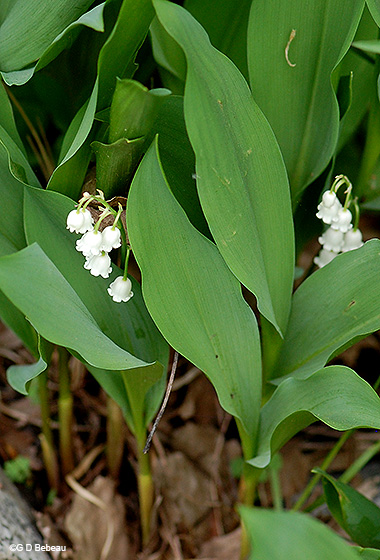
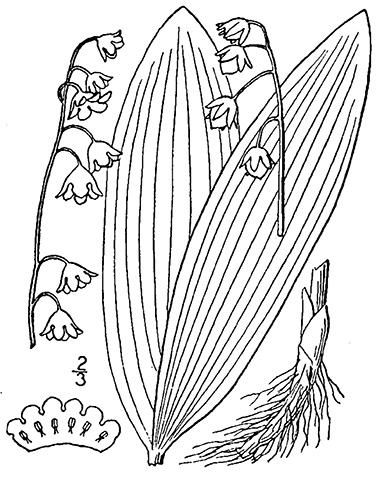
Above: The leaves and the flowering scape all rise directly from the root wihin a basal sheath. Drawing from Britton, N.L., and A. Brown. 1913. An illustrated flora of the northern United States, Canada and the British Possessions. 3 vols. Charles Scribner's Sons, New York.
Below: 1st photo - The bell-shaped flowers are all on one side of the scape. 2nd photo - the basal sheath from which rises the leaves and the scape.
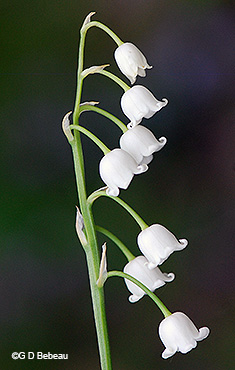
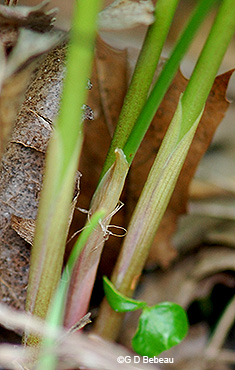
Below: 1st photo - the bell shaped corolla of var. majalis where the entire corolla is white. 2nd photo - Six stamens rise from the base of the perianth around a single style. The red spots are sap, attractive to bees.
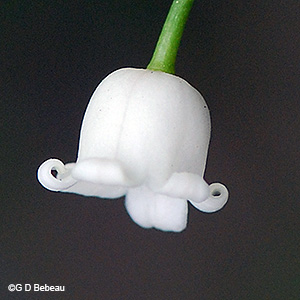
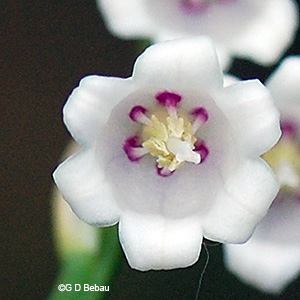
Below: The fruit is a round reddish-orange berry which contains one or two seeds.
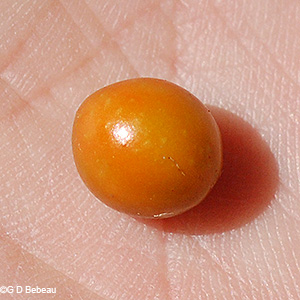
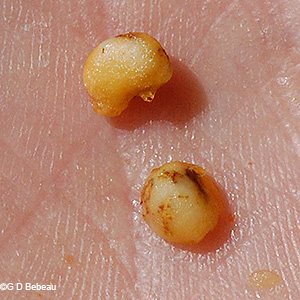
Below: 1st photo - The underside of the leaf showing the veining. In var. majalis this vein network is faintly visible in transmitted light whereas in var. montana, it is clearly visible.
2nd photo - The Canada Mayflower, known as "False Lily of the Valley, Maianthemum canadense
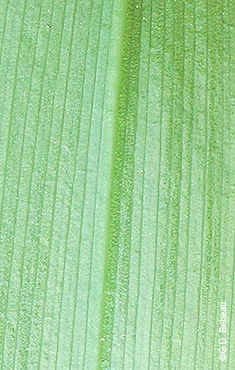
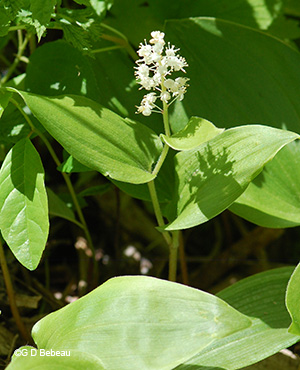
Notes: The European Lily-of-the-Valley has been on Garden plant lists up through the early 2000's. One record of its arrival in the Garden was when Martha Crone planted 37 plants in 1947. She also noted planting the Wild Lily-of-the-Valley, Maianthemum canadense on the same dates. It is usually found in the eastern half of North America. It is known to exist in the wild in parts of Minnesota, being listed on the University of Minnesota's Checklist (Ref. #28C) but the DNR does not inventory it on the county surveys. Most wild specimens are near old gardens, cemeteries, etc.
Toxicity and Medicinal Use: Lily-of-the-Valley flowers, with such a pleasing aroma, have a bitter taste and can lead to poisoning due to the presence of 38 glycosides, the two most prominent being the cardioactive glycosides Convallamarin and Convallarin. Both were used for cardiac patients, similar to Digitalis, but less potent, and thus could be taken more often. It is always the flowers that were used for various other medicinal uses, never the leaves or the root. Mrs. Grieve has a lengthy section on it. (Ref. #7)
Culpepper had this to say: “It is under the dominion of Mercury, and therefore it strengthens the brain, recruits a weak memory, and makes it strong again. The distilled water dropped into the eyes, helps inflammations there, as also that infirmity which they call pin and web. The spirit of the flowers distilled in wine, restoreth lost speech, helps the palsy, and is exceeding good in the apoplexy, and comforters the hearth and vital spirits. Gerrard saith, that the flowers being close stopped up in a glass, put into an ant-hill, and taken away again a month after, ye shall find a liquor in the glass, which being outwardly applied helps the gout.” Nicolas Culpepper The English Physician (1652)
Return to -- Site Plan/Archive Index --or-- List of Common Plant Names -- or -- List of Scientific Names -- or --Home Page - - - Back to top.
References: Plant characteristics are generally from sources 1A, 32, W2, W3, W7 & W8 plus others as specifically applied. Distribution principally from W1, W2 and 28C. Planting history generally from 1, 4 & 4a. Other sources by specific reference. See Reference List for details.
 Identification booklet for most of the flowering forbs and small flowering shrubs of the Eloise Butler Wildflower Garden. Details Here.
Identification booklet for most of the flowering forbs and small flowering shrubs of the Eloise Butler Wildflower Garden. Details Here.
©2017
Friends of the Wildflower Garden, Inc. Text and photos are by G. D. Bebeau unless otherwise credited. "www.friendsofeloisebutler.org"
042020